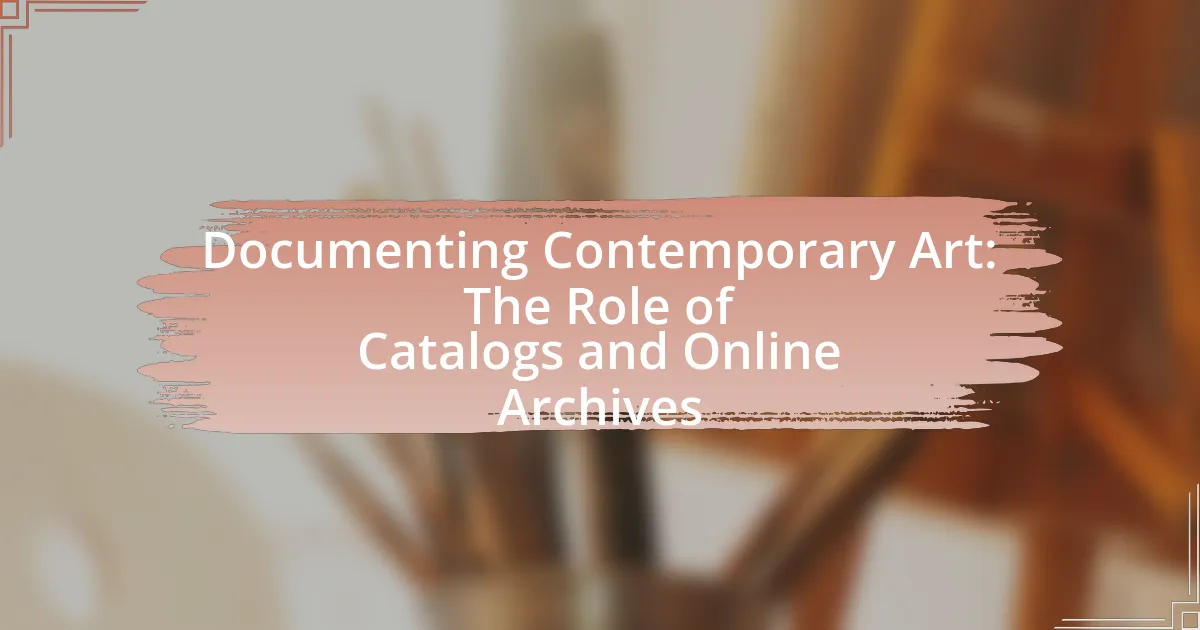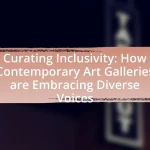Documenting contemporary art is essential for preserving the cultural and historical context of artistic expressions, enabling future generations to analyze trends and individual contributions within art history. This article explores the significance of catalogs and online archives in this documentation process, highlighting their roles in providing comprehensive records of artworks, exhibitions, and artists. It discusses the types of information included in catalogs, the advantages of online archives, and the challenges faced in integrating these resources. Additionally, the article examines emerging trends in technology, such as augmented reality and artificial intelligence, that are shaping the future of art documentation and enhancing accessibility for researchers and the public.
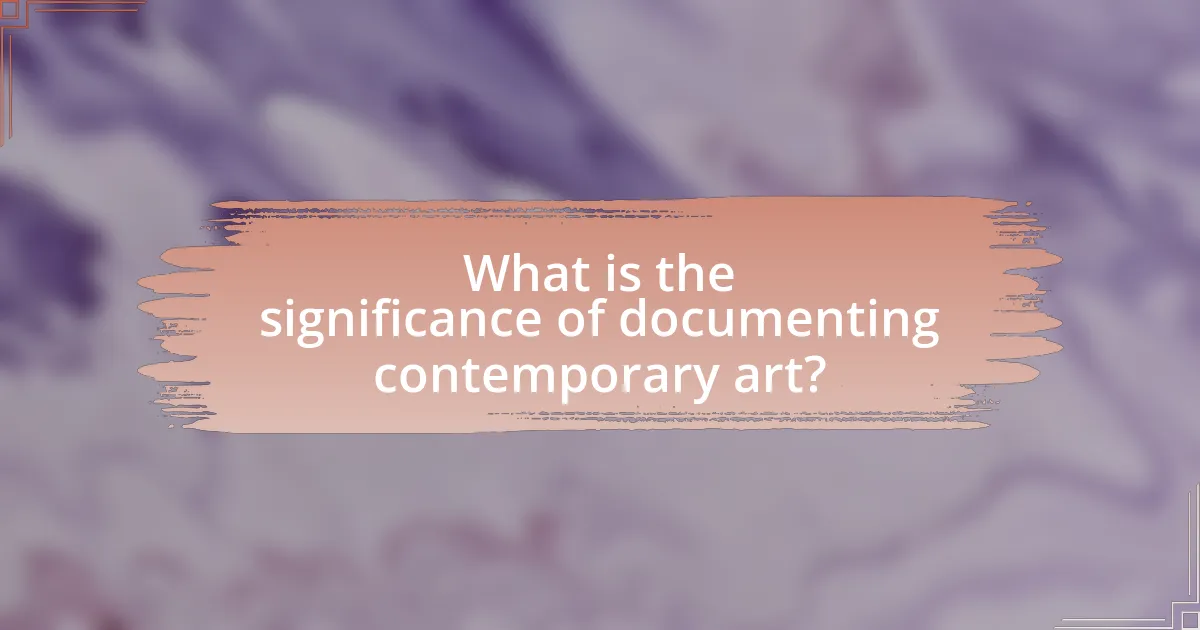
What is the significance of documenting contemporary art?
Documenting contemporary art is significant because it preserves the cultural and historical context of artistic expressions for future generations. This documentation allows for the analysis and understanding of trends, movements, and individual artists’ contributions within the broader narrative of art history. For instance, comprehensive catalogs and online archives provide access to artworks, exhibition details, and critical essays, facilitating research and education. Furthermore, documentation supports the validation of authenticity and provenance, which is crucial in the art market. By maintaining accurate records, institutions and collectors can ensure the integrity of artworks, as seen in the practices of major museums that regularly update their archives to reflect new acquisitions and exhibitions.
Why are catalogs important in the documentation of contemporary art?
Catalogs are important in the documentation of contemporary art because they provide a comprehensive record of artworks, exhibitions, and artists, facilitating research and scholarship. They serve as essential tools for archiving and preserving the context of contemporary art, often including critical essays, artist statements, and high-quality images that enhance understanding. For instance, the catalog for the 2017 Venice Biennale included detailed descriptions and analyses of the works presented, which are invaluable for future reference and study. This documentation supports the art community by ensuring that contemporary works are accessible for historical context and academic inquiry.
What types of information do catalogs typically include?
Catalogs typically include detailed information about artworks, artists, exhibitions, and related events. This information often encompasses descriptions of individual pieces, including title, medium, dimensions, and year of creation, as well as biographical details about the artists, such as their background, influences, and previous exhibitions. Additionally, catalogs may provide contextual information about the exhibition itself, including curatorial statements, thematic explorations, and critical essays that enhance the viewer’s understanding of the artworks presented. This structured approach ensures that catalogs serve as comprehensive resources for both art professionals and the general public, facilitating deeper engagement with contemporary art.
How do catalogs contribute to the understanding of an artist’s work?
Catalogs enhance the understanding of an artist’s work by providing comprehensive documentation of their artworks, exhibitions, and critical reception. These publications often include high-quality images, detailed descriptions, and contextual essays that elucidate the themes and techniques employed by the artist. For instance, a catalog accompanying a retrospective exhibition may feature a chronological overview of the artist’s career, allowing viewers to trace the evolution of their style and concepts over time. Additionally, catalogs often compile scholarly essays and critiques from art historians, which offer insights into the cultural and historical significance of the artist’s work, thereby enriching the viewer’s appreciation and comprehension.
What role do online archives play in documenting contemporary art?
Online archives serve a crucial role in documenting contemporary art by providing accessible platforms for the preservation and dissemination of artistic works and related information. These digital repositories enable artists, curators, and researchers to store and share high-quality images, exhibition catalogs, and critical essays, ensuring that contemporary art is recorded and made available to a global audience. For instance, institutions like the Museum of Modern Art (MoMA) and the Getty Research Institute maintain extensive online archives that include digitized collections and scholarly resources, facilitating research and education in the field. This accessibility not only democratizes art appreciation but also supports the ongoing dialogue about contemporary art practices and their historical context.
How do online archives differ from traditional catalogs?
Online archives differ from traditional catalogs primarily in their accessibility and interactivity. Online archives provide digital access to a vast array of documents, images, and multimedia, allowing users to search and explore content remotely at any time, while traditional catalogs often require physical presence and may have limited access to materials. Additionally, online archives frequently incorporate advanced search functionalities, metadata tagging, and user-generated content, enhancing user engagement and facilitating more dynamic interactions compared to the static nature of traditional catalogs. This shift towards digital platforms reflects the growing trend in contemporary art documentation, where immediacy and user accessibility are prioritized.
What advantages do online archives offer to researchers and the public?
Online archives provide researchers and the public with enhanced accessibility to a vast array of information and resources. These digital platforms allow users to access historical documents, artworks, and scholarly articles from anywhere in the world, significantly reducing geographical barriers. For instance, the Smithsonian Institution’s online archives offer access to over 3 million digital assets, enabling researchers to explore collections that were previously limited to physical visits. Additionally, online archives often include advanced search functionalities, making it easier to locate specific materials quickly. This ease of access and searchability supports more efficient research processes and fosters greater public engagement with contemporary art and history.
How do catalogs and online archives intersect in contemporary art documentation?
Catalogs and online archives intersect in contemporary art documentation by serving complementary roles in the preservation and accessibility of artistic works. Catalogs provide curated, physical or digital collections that often include detailed descriptions, critical essays, and contextual information about artworks, while online archives offer broader access to a wider range of materials, including images, videos, and artist interviews. This intersection enhances the documentation process by allowing for both in-depth scholarly analysis through catalogs and expansive public engagement via online platforms. For instance, institutions like the Museum of Modern Art utilize both catalogs for exhibitions and online archives to make their collections accessible globally, thereby enriching the understanding and appreciation of contemporary art.
What are the challenges of integrating catalogs with online archives?
Integrating catalogs with online archives presents several challenges, primarily related to data compatibility, metadata standards, and user accessibility. Data compatibility issues arise when different systems use varying formats, making it difficult to merge information seamlessly. Metadata standards pose a challenge as catalogs and archives may not adhere to the same classification systems, leading to inconsistencies in how information is categorized and retrieved. Additionally, user accessibility can be hindered by the complexity of navigating multiple platforms, which may deter users from effectively utilizing the integrated resources. These challenges highlight the need for standardized protocols and user-friendly interfaces to enhance the integration process.
How can artists utilize both catalogs and online archives effectively?
Artists can utilize both catalogs and online archives effectively by integrating them into their research and promotional strategies. Catalogs provide curated collections of artworks, exhibition details, and critical essays that can enhance an artist’s understanding of their context within the art world. Online archives, on the other hand, offer broader access to historical and contemporary works, enabling artists to study trends, techniques, and influences across various movements. By cross-referencing information from catalogs with the extensive resources available in online archives, artists can gain a comprehensive view of their practice and identify opportunities for collaboration, exhibition, and audience engagement. This dual approach not only enriches their artistic development but also increases visibility and accessibility in the competitive art market.
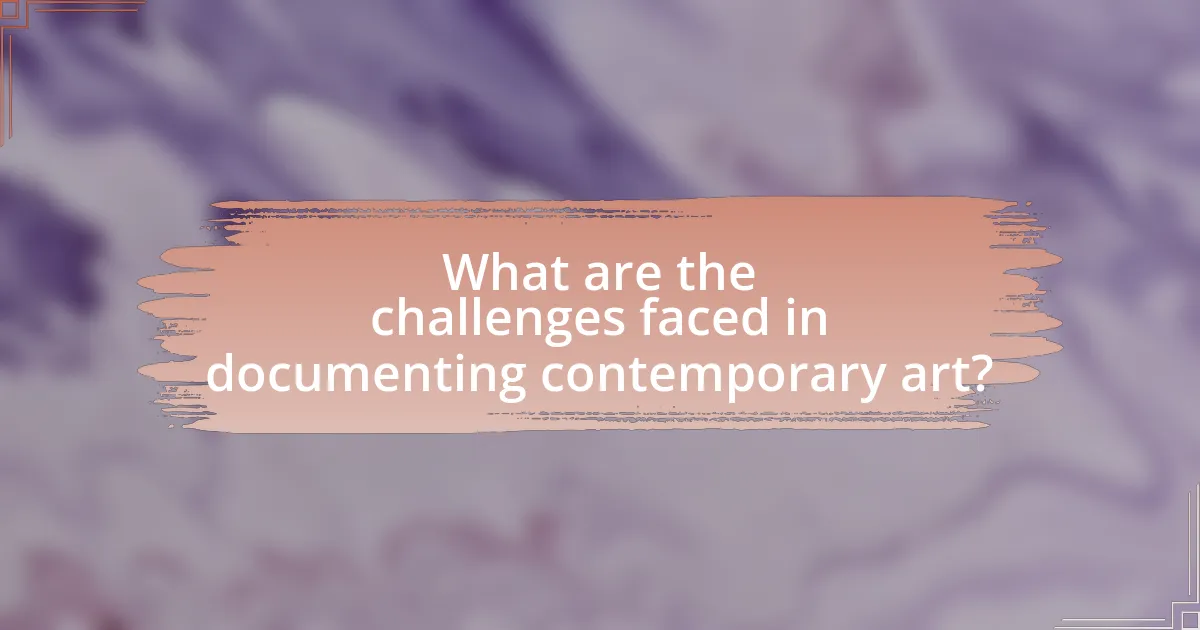
What are the challenges faced in documenting contemporary art?
The challenges faced in documenting contemporary art include the rapid evolution of artistic practices, the diversity of media, and the lack of standardized documentation methods. Contemporary art often incorporates transient materials and performance elements, making it difficult to capture and preserve. Additionally, the wide range of artistic expressions, from digital installations to social practice, complicates the creation of comprehensive records. The absence of universally accepted guidelines for documentation further exacerbates these issues, leading to inconsistencies in how artworks are archived and represented.
What issues arise in the creation of art catalogs?
The creation of art catalogs often faces issues related to accuracy, representation, and accessibility. Accuracy is crucial as catalogs must provide correct information about artworks, including details like artist names, titles, and dates; errors can mislead audiences and diminish the catalog’s credibility. Representation issues arise when catalogs fail to include diverse artists or perspectives, potentially perpetuating biases in the art world. Accessibility concerns involve the physical and digital formats of catalogs; if they are not widely available or user-friendly, they limit the audience’s ability to engage with the art. These issues highlight the complexities involved in documenting contemporary art effectively.
How do financial constraints impact the production of catalogs?
Financial constraints significantly limit the production of catalogs by reducing available budgets for design, printing, and distribution. When organizations face financial limitations, they often prioritize essential expenses, leading to fewer catalogs being produced or resulting in lower-quality materials. For instance, a study by the National Endowment for the Arts found that budget cuts in arts organizations directly correlate with a decrease in the number of published catalogs, impacting the documentation of contemporary art. This reduction in catalog production can hinder the visibility and accessibility of artists’ works, ultimately affecting their market presence and audience engagement.
What are the common pitfalls in cataloging contemporary art?
Common pitfalls in cataloging contemporary art include inadequate documentation, lack of standardization, and insufficient context. Inadequate documentation often leads to missing crucial information about the artwork, such as the artist’s intent or the work’s historical significance. Lack of standardization can result in inconsistent terminology and classification, making it difficult for researchers and audiences to navigate the catalog. Insufficient context may overlook the socio-political influences or cultural background that inform the artwork, diminishing its understanding and appreciation. These pitfalls can hinder the effectiveness of catalogs and online archives in preserving and promoting contemporary art.
What limitations do online archives encounter?
Online archives encounter limitations such as accessibility issues, data preservation challenges, and copyright restrictions. Accessibility issues arise when users face difficulties navigating platforms or when archives are not optimized for various devices, limiting user engagement. Data preservation challenges include the risk of digital decay and the need for ongoing maintenance to ensure that files remain retrievable over time. Copyright restrictions can hinder the availability of certain materials, as legal constraints may prevent the inclusion of specific artworks or documents, thereby limiting the comprehensiveness of the archive. These limitations impact the effectiveness of online archives in documenting contemporary art.
How does digital preservation affect the accessibility of contemporary art?
Digital preservation significantly enhances the accessibility of contemporary art by ensuring that artworks, exhibitions, and related materials are stored in digital formats that can be easily accessed and shared. This process allows institutions and artists to reach a global audience, as digital archives can be accessed from anywhere with an internet connection. For instance, the Museum of Modern Art (MoMA) has digitized a substantial portion of its collection, making it available online, which has led to increased engagement and educational opportunities for diverse audiences. Furthermore, digital preservation mitigates the risk of loss due to physical deterioration or disasters, thereby safeguarding cultural heritage and ensuring that contemporary art remains available for future generations.
What are the ethical considerations in online archiving of art?
The ethical considerations in online archiving of art include issues of copyright, cultural sensitivity, and the representation of artists. Copyright laws dictate that the rights of artists and creators must be respected, ensuring that their works are not used without permission or proper attribution. Cultural sensitivity is crucial, particularly when archiving works from marginalized communities, as it involves respecting the cultural significance and context of the art. Additionally, the representation of artists in online archives must be accurate and equitable, avoiding biases that could misrepresent their contributions. These considerations are essential to maintain integrity and respect within the art community.
How can these challenges be addressed?
To address the challenges in documenting contemporary art, implementing standardized cataloging practices is essential. Standardization ensures consistency in how artworks are described, making it easier for researchers and the public to access and understand the information. For instance, the use of controlled vocabularies, such as the Art & Architecture Thesaurus, can enhance the clarity and searchability of online archives. Additionally, investing in digital preservation technologies can safeguard against data loss, as evidenced by the 2017 report from the Library of Congress, which highlights the importance of digital preservation in maintaining access to cultural heritage. Furthermore, fostering collaboration among institutions can lead to shared resources and knowledge, improving the overall quality of documentation in the field.
What best practices can be implemented for effective documentation?
Effective documentation can be achieved by implementing best practices such as maintaining consistency in formatting, using clear and concise language, and organizing information logically. Consistency in formatting ensures that all documents adhere to the same style, making them easier to read and navigate. Clear and concise language eliminates ambiguity, allowing the intended message to be communicated effectively. Organizing information logically, such as using headings and subheadings, helps users find relevant content quickly. These practices are supported by research indicating that well-structured documentation improves user comprehension and retention, as evidenced by studies in information design and usability.
How can collaboration enhance the documentation process?
Collaboration enhances the documentation process by integrating diverse perspectives and expertise, which leads to more comprehensive and accurate records. When multiple individuals contribute, they bring unique insights that can fill gaps in knowledge and ensure that various aspects of contemporary art are represented. For instance, a study by the Getty Research Institute highlights that collaborative documentation efforts can result in richer narratives and a more nuanced understanding of artworks, as different stakeholders, such as artists, curators, and historians, share their interpretations and contextual information. This collective approach not only improves the quality of documentation but also fosters a sense of community and shared responsibility in preserving contemporary art.
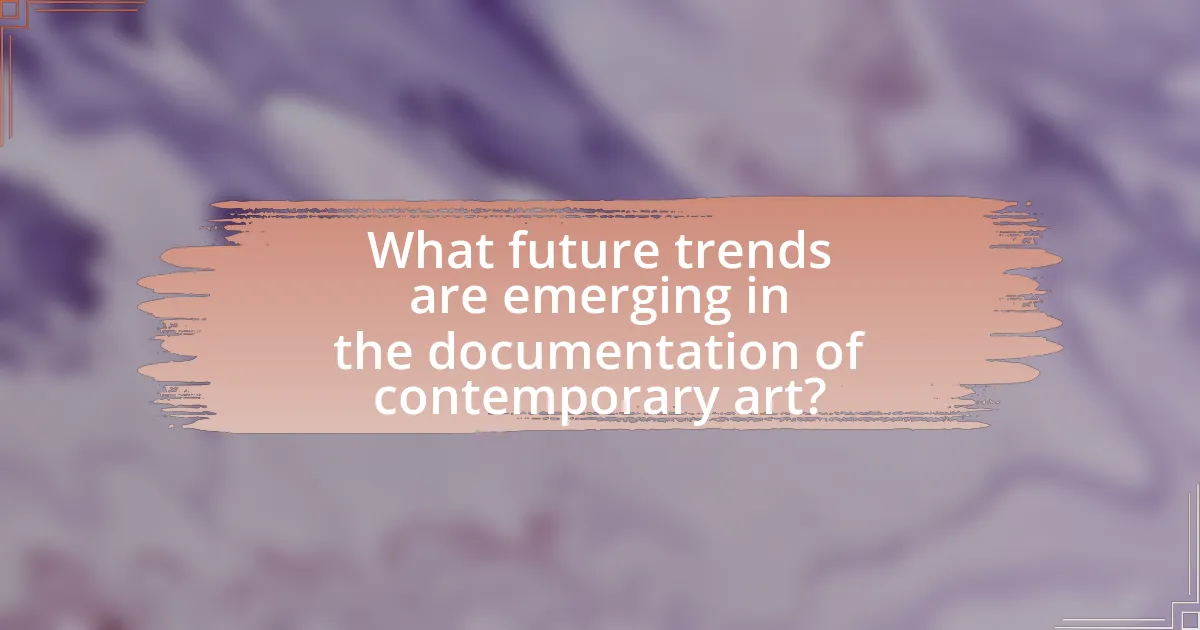
What future trends are emerging in the documentation of contemporary art?
Future trends in the documentation of contemporary art include the increasing use of digital platforms, augmented reality, and blockchain technology. Digital platforms enable broader accessibility and engagement, allowing audiences to interact with artworks through virtual exhibitions and online catalogs. Augmented reality enhances the viewer’s experience by overlaying digital information onto physical artworks, creating immersive environments. Blockchain technology offers secure provenance tracking and ownership verification, which is crucial for the authenticity of contemporary art. These trends reflect a shift towards more interactive, transparent, and accessible documentation methods in the art world.
How is technology shaping the future of art catalogs?
Technology is significantly shaping the future of art catalogs by enabling digital archiving, enhancing accessibility, and facilitating interactive experiences. Digital platforms allow for the creation of comprehensive online catalogs that can be updated in real-time, making artworks more accessible to a global audience. For instance, institutions like the Museum of Modern Art have adopted digital catalogs that include high-resolution images and detailed descriptions, allowing users to explore collections from anywhere. Additionally, technologies such as augmented reality (AR) and virtual reality (VR) are being integrated into art catalogs, providing immersive experiences that engage users in new ways. This shift towards digital formats not only preserves artworks but also democratizes access, as evidenced by the increase in online viewership of art collections, which surged by over 50% during the COVID-19 pandemic.
What role do augmented and virtual reality play in art documentation?
Augmented and virtual reality significantly enhance art documentation by providing immersive experiences that allow viewers to engage with artworks in innovative ways. These technologies enable the creation of interactive digital catalogs and online archives, where users can explore 3D representations of art pieces, view them from multiple angles, and access contextual information seamlessly. For instance, museums like the Smithsonian have utilized augmented reality to overlay historical data and artist insights directly onto artworks, enriching the viewer’s understanding and appreciation. This integration of AR and VR not only preserves the visual integrity of art but also democratizes access, allowing a global audience to experience exhibitions remotely, as demonstrated by initiatives like the Google Arts & Culture platform, which offers virtual tours of renowned galleries.
How can artificial intelligence improve cataloging processes?
Artificial intelligence can improve cataloging processes by automating data entry and enhancing metadata accuracy. AI algorithms can analyze large datasets to identify patterns and categorize artworks efficiently, reducing human error and time spent on manual tasks. For instance, machine learning models can recognize visual elements in artworks, enabling automatic tagging and classification based on style, medium, and artist. This capability not only streamlines the cataloging process but also ensures that information is consistently updated and relevant, as AI systems can learn from new data inputs. Studies have shown that implementing AI in cataloging can increase efficiency by up to 50%, allowing institutions to manage larger collections with greater precision.
What innovations are being introduced in online archives?
Innovations in online archives include the integration of artificial intelligence for enhanced search capabilities, the use of virtual reality for immersive experiences, and the implementation of blockchain technology for secure provenance tracking. These advancements allow users to access and interact with archival materials more efficiently and securely. For instance, AI algorithms can analyze and categorize vast amounts of data, making it easier for researchers to find relevant information quickly. Virtual reality can provide users with a 3D exploration of art pieces and exhibitions, enriching the viewing experience. Blockchain ensures that the ownership and history of digital artworks are verifiable, thus increasing trust in online transactions.
How are social media platforms influencing art documentation?
Social media platforms are significantly influencing art documentation by providing artists and institutions with immediate access to a global audience, facilitating real-time sharing and engagement with artworks. This shift allows for diverse forms of documentation, such as live-streamed exhibitions, interactive posts, and user-generated content, which enhance the visibility and accessibility of art. For instance, platforms like Instagram have become essential for artists to showcase their work, leading to increased documentation of contemporary art practices and trends. According to a study by the Pew Research Center, 72% of adults use social media, indicating a vast potential for art documentation to reach a wide demographic. This democratization of art documentation not only preserves artworks in digital formats but also fosters community discussions and critiques, reshaping how art history is recorded and experienced.
What new models of collaboration are emerging in online archiving?
New models of collaboration in online archiving include decentralized platforms that leverage blockchain technology for secure and transparent data sharing. These platforms enable multiple stakeholders, such as artists, institutions, and collectors, to contribute and access archival materials while maintaining ownership and provenance. For instance, initiatives like Artory and Verisart utilize blockchain to create immutable records of artworks, enhancing trust and collaboration among participants. Additionally, collaborative digital archives are emerging, where institutions partner to share resources and expertise, exemplified by projects like Europeana, which aggregates cultural heritage collections from various European institutions, fostering a collective approach to archiving.
What practical steps can artists take to adapt to these trends?
Artists can adapt to trends in documenting contemporary art by actively engaging with online platforms and creating digital catalogs of their work. By utilizing social media and dedicated art websites, artists can reach broader audiences and showcase their portfolios effectively. Additionally, artists should consider collaborating with online archives to ensure their work is preserved and accessible for future reference. Research indicates that digital presence significantly enhances visibility; for instance, a study by the National Endowment for the Arts found that artists with an online portfolio are 50% more likely to be discovered by galleries and collectors.
How can artists leverage new technologies for better documentation?
Artists can leverage new technologies for better documentation by utilizing digital tools such as high-resolution photography, video recording, and cloud storage systems. These technologies enable artists to create detailed visual records of their work, capturing the nuances of their art in ways that traditional methods cannot. For instance, high-resolution images allow for the preservation of intricate details, while video documentation can showcase the process and context of the artwork. Additionally, cloud storage provides a secure and accessible platform for organizing and sharing these documents, facilitating easier collaboration and archiving. According to a study by the International Council of Museums, digital documentation enhances the visibility and accessibility of contemporary art, allowing artists to reach broader audiences and maintain a comprehensive archive of their work.
What resources are available for artists to enhance their documentation practices?
Artists can enhance their documentation practices through various resources, including online platforms, workshops, and software tools. Online platforms such as ArtBinder and Artwork Archive provide artists with user-friendly interfaces to catalog their work, manage inventory, and track sales. Workshops offered by organizations like the College Art Association focus on best practices for documentation, including photography and archiving techniques. Additionally, software tools like Adobe Lightroom and Google Drive facilitate the organization and storage of digital files, ensuring that artists maintain comprehensive records of their work. These resources collectively support artists in creating thorough and accessible documentation of their artistic practices.
